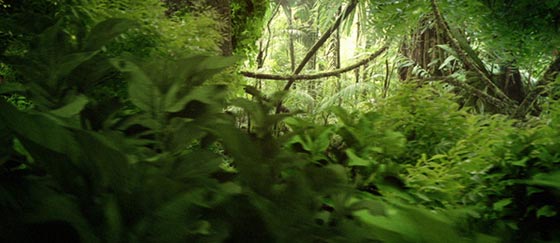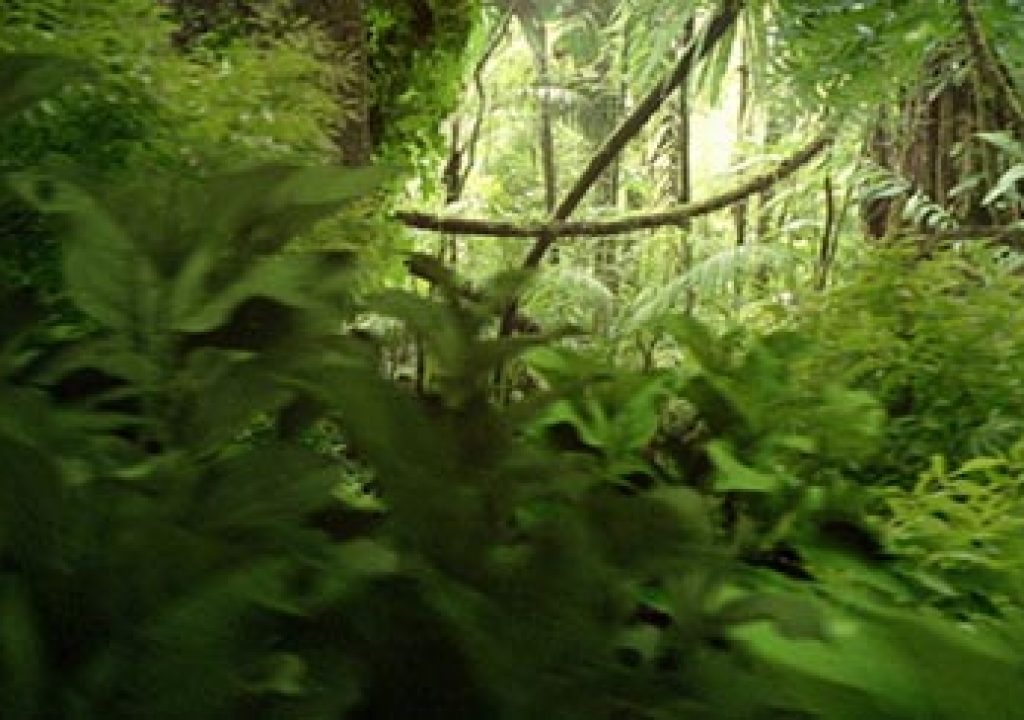
It was an average week with assorted After Effects tutorials, tips, and scripts & plug-ins new and old.
The Jungle by Andrew Kramer (pictured) creates “an overgrown jungle scene with a rocky title using images and built-in effects. There is also a mini-Photoshop tutorial about extracting plants from images.” Like most AE projects, it calls for a good eye and a sense of motion rather than pyrotechnics, though Freddie Wong could be hiding muzzle flashes in the shadows. There should be more excitement soon, as Video Copilot Element is rumored to be nearing release with an impressive way to create and extrude text and mask shapes, along with other features mentioned in an earlier preview. [Update: Andrew added an Overgrown Bonus Tutorial! using the CC Hair effect to create some overgrown bits of grass on his text.]
With Studying 3D Camera Tracker, Jerzy Drozda Jr (aka maltaannon) has over 70 minutes of training on this feature: “I’ve tried many match-moving applications over the years, and nothing beats the build-in 3D Camera Tracker in After Effects CS6, even though it’s fully automatic with no manual control over the tracking process. Simply amazing.[…] Some time ago I’ve posted a short introduction video on YouTube about the new 3D Camera Tracker available in After Effects CS6. I’ve got a lot of comments and questions since then, so I decided to make a more in-depth video on the various aspects of match-moving.”
Brian Maffitt also posted an intro video and Todd Kopriva has advice on memory and storage tips for Warp Stabilizer and 3D Camera Tracker (it appears that data for the CS6 3D Camera Tracker is stored along with the effect in the project file). Here’s Brian and maltaannon:
Episode 80 – Autumn Colors: Motion Graphics with Trapocode Particular, Owain Street brings “it back to basics, with Trapcode Particular. This is definitely more of a beginner tutorial, so if you’re new to Particular, this will be great place to get started.” See also Particular 2: Overview by Jerzy Drozda Jr.
Rob Garrott at Lynda.com shares the most basic ideas in Creating a motion blur, from the Lynda.com Design in Motion series. For more on motion blur, see the mini-roundup Adding motion blur in After Effects here on PVC.
Andrew Devis has more AE Basics 46: Mask Feather Tool (CS6 & above), some basic videos on the Paint Panel in AE, and a host of videos on Premiere Pro CS6 Techniques. See also AE Help on Variable Mask Feathering, as well as Brian Maffitt with his tutorials After Effects CS6 Essentials Variable Mask Feathering, part 1 and part 2.
Mamoworld’s latest tutorial is Trapcode 3D Stroke, which combines Trapcode Sound Keys with Audio iExpressions, along with various tools from the Trapcode Suite, to create an audio reactive logo animation. See also the older mini-roundup Audio waveform graphics in After Effects. In addition, check out the free new preset by Victoria Nece in Get the look of Trapcode’s 3D Stroke with no plugins!. For similar looks, see the mini-roundup Colored Light Strokes and Streaks.
Create Your Own Flourishes… Now in 3D! by Kevin Snyder uses Illustrator to create a flourish style design, animate the growth of the design in After Effects, and then extrude the paths into 3D space with the new 3D options in After Effects CS6 ‘to give an “old” look some new life. The idea is to feel like animated strips of paper in 3d space.’
Video Cards for After Effects CS6 by Studio1Productions shows many aspects on how to unlock After Effects CS6 to use almost any NVIDIA graphics card for using the new ray-traced 3D rendering engine, and tracks reports of results. To cut through the noise on that page, to enable ray-tracing on an unsupported card on Windows, all you need to do is open raytracer_supported_cards.txt (in the AE app folder) and add your card, for example GeForce GTX 560M. There were some instructions for something similar on the Mac at Insanely Mac in How To Cuda / Mercury Engine on Premiere CS5 / Snow Leopard [lower end graphic cards] (video). These were for the Premiere pref, so open the raytracer list instead.
OpenCL and Premiere Pro CS6 from Todd Kopriva says that the Mercury Engine accelerated processing is supported AMD Radeon HD 6750M and 6770M graphics card with 1GB VRAM in MacBook Pro computers running Mac OSX v10.7. But as you may guess, some AMD/ATI cards in iMacs may also work — unofficially — as shown by Steve Oakley and by Kanen in Mercury Playback on a 27″ iMac with AMD Radeon 6970M (Premiere Pro CS6):
Daniel Savage discusses how to Create a 3D isometric effect in After Effects at Computer Arts. Here’s an example render; tutorial project files are available too:
Continued…
“Screen Fillers” Graphic User Interface Elements by Stefan Surmabojov is a series of tutorials on AEtuts. For more on HUDs, see Designing & Compositing a HUD, Tidbits on futuristic screen and UI designs, Compositing an Advanced HUD – Complete Video Workshop (a tutorial series by CG Swot), and the HUD collection in the AE Portal archive. In the news lately is the HUD/UI work for The Avengers, with articles like VFX roll call for The Avengers (updated) by Mike Seymour, We Talk to the Creator of The Avengers UI and Iron Man’s HUD, and The craft of screen graphics and movie user interfaces – conversation with Jayse Hansen.
Here’s Stefan’s intro (he also posted the useful Radio Waves filter demo in Create an Awesome Wireframe Pulse Effect with Cinema 4D & After Effects):
Clay Asbury posted After Effects Preferences-5 Quicktips.
FCP.CO noted the Mindtransplant update ClipExporter for getting FCPX projects and clips into After Effects.
Beyond Camera Basics – Focal Length by Jesse Toula discusses basic principles of lenses like focal length and aperture as well as concepts like depth of field and circles of confusion.
In Stories of Growth: Process and Breakdown, Simon Stutts builds an animation of tree growth in After Effects “using Advanced Lightning to animate the growth of the root system, and Particular to animate the tree and leaf growth. I opted for Advanced Lightning and Particular because I knew that I could get a very slick looking end result, while still moving quickly and keeping my effect controls centralized – instead of a ton of different elements to keep track of, animate, and control, I could use a few effect instances to drive the entire process.” Here’s the render:
VFXBro posted After Effects CS6 Tutorial – Raytracing and a few other new tutorials.
Evan Abrams posted a few tutorials on the Render Queue — The Render Queue: Overview, The Render Queue: Output Module, and The Render Queue: Render Settings. Also, CreativeDojo added Changing Multiple Render Output Modules at Once.
In AE CS6 – Pro Import After Effects, “Kevin P McAuliffe shows you the newly integrated Automatic Duck Pro Import into After Effects CS6. Now called simply Pro Import After Effects, this fantastic tool will give you a bridge from Final Cut Pro 6/7, Motion or Media Composer/Symphony right into an AE composition.”
Please note that these roundups are for quick review and comparison. There is almost always vital information from the originating authors at the links provided-and often free presets, projects, or stock footage too.

Filmtools
Filmmakers go-to destination for pre-production, production & post production equipment!
Shop Now













